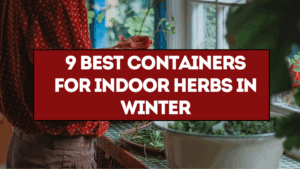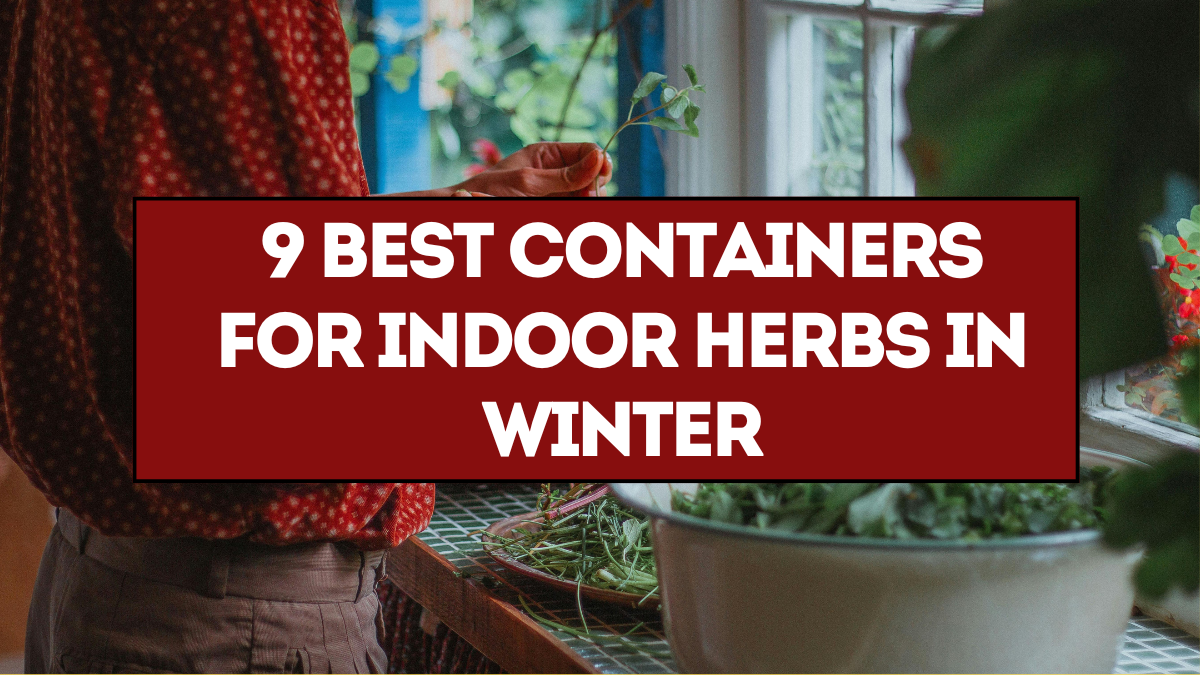Growing herbs indoors during the chilly winter months is one of the most rewarding gardening practices. Fresh herbs like basil, parsley, mint, oregano, thyme, and chives not only elevate your cooking but also bring a burst of greenery to your windowsill. However, the success of indoor herb gardening heavily depends on one factor: choosing the best containers for indoor herbs in winter. The right pot provides good drainage, proper aeration, and the right size for healthy root growth.
In winter, when daylight is shorter and indoor air is drier, herbs are especially sensitive to soil moisture and container conditions. Using the wrong container—whether it holds too much water, dries out too quickly, or restricts roots—can lead to poor growth or plant death. To help you avoid these pitfalls, we’ve compiled a detailed list of the nine best types of pots for growing herbs indoors during winter, along with guidance on size, drainage, and placement.

Why Container Choice Matters for Winter Herbs
When herbs are grown outdoors in garden beds, their roots can spread freely. But in containers, the space is limited. In winter, low light and reduced air circulation make roots even more vulnerable to rot, fungus, and stunted growth. The right container ensures:
-
Adequate drainage so roots don’t sit in soggy soil
-
Stable moisture that isn’t lost too quickly in heated indoor air
-
Correct size so roots have enough room without being waterlogged
-
Good airflow around soil particles for healthy root development
A well-chosen pot balances these needs and creates the perfect microenvironment for your herbs.
1. Terracotta Pots – The Classic Choice
Terracotta pots are one of the best containers for herbs indoors, especially for those prone to overwatering. These clay-based pots are porous, allowing moisture and air to move through the pot walls.
Benefits:
-
Prevent soil from staying too wet
-
Naturally breathable, reducing root rot risk
-
Traditional and decorative look for windowsills
Best for: Mediterranean herbs like oregano, thyme, and rosemary, which prefer slightly drier conditions.
Tip: In winter, check soil often because terracotta can dry out faster in heated rooms.
2. Plastic Pots – Lightweight and Moisture-Retentive
Plastic pots are budget-friendly and lightweight, making them ideal for windowsills or shelves. Unlike terracotta, they retain moisture for longer, which is useful in dry indoor environments.
Benefits:
-
Lightweight and easy to move
-
Available in many sizes and styles
-
Hold moisture well in heated homes
Best for: Moisture-loving herbs like parsley, basil, and mint.
Tip: Choose BPA-free or food-safe plastic for herbs you plan to consume regularly.
3. Self-Watering Containers – Stress-Free Winter Watering
Self-watering pots are excellent for gardeners who travel or forget to water regularly. These containers use a reservoir and wick system that allows plants to draw water as needed.
Benefits:
-
Prevent underwatering in heated indoor air
-
Reduce frequency of watering
-
Consistent moisture levels for steady growth
Best for: Herbs that prefer consistently moist soil, such as chives, mint, and basil.
Tip: Empty the reservoir occasionally to avoid stagnant water and root disease.
4. Ceramic Glazed Pots – Stylish Yet Functional
Glazed ceramic pots combine the looks of terracotta with the moisture retention of plastic. The glaze prevents water from escaping through the sides, so they hold moisture better than unglazed clay.
Benefits:
-
Attractive designs for interior décor
-
Hold moisture longer in dry rooms
-
Heavy base prevents tipping on windowsills
Best for: Decorative indoor setups with herbs like thyme, sage, and oregano.
Tip: Ensure they have a drainage hole; if not, use them as decorative covers for functional nursery pots.
5. Metal Containers – Modern and Durable
Metal pots add a sleek, modern look to indoor gardens. Stainless steel or galvanized containers can work well if properly managed.
Benefits:
-
Long-lasting and stylish
-
Excellent for grouped arrangements
-
Can be reused for many seasons
Best for: Hardy herbs like chives and parsley.
Tip: Always ensure they have drainage holes, as metal containers can trap water and overheat near windows.
6. Wooden Planter Boxes – Natural and Insulating
Wooden planters provide insulation against cold drafts, making them suitable for herbs near drafty windows. They can also be custom-sized for small or large herb collections.
Benefits:
-
Natural insulation keeps roots stable in winter
-
Eco-friendly and rustic look
-
Can be partitioned for multiple herbs
Best for: Mixed herb gardens with basil, parsley, and cilantro.
Tip: Line wooden planters with plastic to prevent rotting and improve moisture control.
7. Fabric Grow Bags – Breathable and Root-Friendly
Fabric grow bags are lightweight and breathable, preventing roots from becoming pot-bound. They are especially good for gardeners with limited space.
Benefits:
-
Provide natural air pruning for roots
-
Prevent overheating or overwatering
-
Easy to move and store when not in use
Best for: Fast-growing herbs like dill, basil, and coriander.
Tip: Place a tray underneath to catch extra water and prevent mess indoors.
8. Hanging Containers – Maximize Space
Hanging baskets or vertical wall-mounted planters are perfect for small apartments or kitchens with limited counter space.
Benefits:
-
Save valuable windowsill space
-
Allow herbs to cascade beautifully
-
Work well near south-facing windows or under grow lights
Best for: Trailing herbs like oregano, thyme, and mint.
Tip: Choose lightweight containers with drainage holes and hang them securely.
9. Recycled and DIY Containers – Budget-Friendly Options
For eco-conscious gardeners, repurposing containers like old mugs, tins, or jars can work with the right modifications.
Benefits:
-
Low-cost and sustainable
-
Creative and unique décor
-
Perfect for small herb plants
Best for: Small herbs like chives, parsley, and microgreens.
Tip: Drill drainage holes in the bottom or add a layer of pebbles to prevent waterlogging.
Container Size and Drainage Guide
-
Small herbs (chives, thyme, oregano): 4–6 inch pots
-
Medium herbs (parsley, cilantro, basil): 6–8 inch pots
-
Large herbs (mint, rosemary, sage): 8–12 inch pots
Always ensure containers have at least one drainage hole. Herbs hate sitting in stagnant water, especially in low-light winter conditions.
Extra Winter Care for Indoor Herbs
-
Place pots on sunny windowsills or supplement with grow lights for 10–12 hours of light.
-
Rotate containers weekly for even growth.
-
Avoid placing pots near heating vents, which dry out soil.
-
Group containers together to create a microclimate with higher humidity.
By combining the right container with smart winter care, you’ll enjoy fresh herbs all season long.
FAQs
Which is better for indoor herbs: terracotta or plastic pots?
Terracotta is great for herbs that prefer drier soil, while plastic works better for moisture-loving herbs in dry winter air.
Do herbs need drainage holes in winter pots?
Yes, proper drainage is essential year-round to prevent root rot, especially indoors during winter.
Are self-watering pots good for herbs?
Yes, but they work best for herbs that like consistent moisture, such as basil and mint.
Can I grow herbs on a windowsill in winter?
Yes, south-facing or well-lit windowsills are ideal, but supplement with grow lights if natural light is insufficient.
What size pot is best for indoor herbs?
Small herbs need 4–6 inches, medium herbs 6–8 inches, and larger ones 8–12 inches deep.
Click here to know more.
